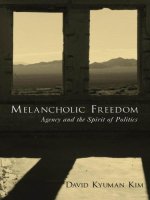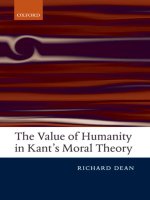- Trang chủ >>
- Khoa Học Tự Nhiên >>
- Vật lý
the vicar of wakefield jun 2006
Bạn đang xem bản rút gọn của tài liệu. Xem và tải ngay bản đầy đủ của tài liệu tại đây (710.58 KB, 246 trang )
oxford world’s classics
THE VICAR OF WAKEFIELD
Oliver Goldsmith was born in 1730(?), the second son of
Charles Goldsmith, curate of the parish of Kilkenny West in West
Meath in Ireland. In 1745 he was admitted to Trinity College
Dublin. He quickly dissipated his savings by gambling, which was
to become an abiding interest. After periods at the Universities of
Edinburgh and Leyden he spent 1755–6 travelling in Europe, where
he is reputed to have eked out a living by playing the flute and
disputing doctrinal points at monasteries and universities. Before
embarking on a writing career he worked in London as an
apothecary’s assistant, a doctor, and a school usher. A combination
of overwork, worry, and poor self-treatment hastened his death
in 1774.
Goldsmith’s ability and range as a professional writer were
considerable. Best known perhaps for The Vicar of Wakefield, he was
also the author of biographies, anthologies, translations, poems (The
Traveller, 1764, and The Deserted Village, 1770), plays (She Stoops to
Conquer, 1773), as well as numerous reviews and essays.
Arthur Friedman is the late distinguished Professor of English at
the University of Chicago and editor of Goldsmith’s Collected Works.
Robert L. Mack is a lecturer in the School of English at the
University of Exeter. He has previously taught at Princeton University
and Vanderbilt University, and is the editor of the Arabian Nights’
Entertainments and Oriental Tales for Oxford World’s Classics. His biog-
raphy of the poet Thomas Gray was published by Yale University Press
in 2000.
oxford world’s classics
For over 100 years Oxford World’s Classics have brought
readers closer to the world’s great literature. Now with over 700
titles—from the 4,000-year-old myths of Mesopotamia to the
twentieth century’s greatest novels—the series makes available
lesser-known as well as celebrated writing.
The pocket-sized hardbacks of the early years contained
introductions by Virginia Woolf, T. S. Eliot, Graham Greene,
and other literary figures which enriched the experience of reading.
Today the series is recognized for its fine scholarship and
reliability in texts that span world literature, drama and poetry,
religion, philosophy and politics. Each edition includes perceptive
commentary and essential background information to meet the
changing needs of readers.
OXFORD WORLD’S CLASSICS
OLIVER GOLDSMITH
The Vicar of Wakefield
Edited by
ARTHUR FRIEDMAN
With an Introduction and Notes by
ROBERT L. MACK
1
3
Great Clarendon Street, Oxford ox2 6dp
Oxford University Press is a department of the University of Oxford.
It furthers the University’s objective of excellence in research, scholarship,
and education by publishing worldwide in
Oxford New York
Auckland Cape Town Dar es Salaam Hong Kong Karachi
Kuala Lumpur Madrid Melbourne Mexico City Nairobi
New Delhi Shanghai Taipei Toronto
With offices in
Argentina Austria Brazil Chile Czech Republic France Greece
Guatemala Hungary Italy Japan Poland Portugal Singapore
South Korea Switzerland Thailand Turkey Ukraine Vietnam
Oxford is a registered trade mark of Oxford University Press
in the UK and in certain other countries
Published in the United States
by Oxford University Press Inc., New York
Editorial matter © Robert L. Mack 2006
The moral rights of the author have been asserted
Database right Oxford University Press (maker)
First published as a World’s Classics paperback 1981
Reissued as an Oxford World’s Classics paperback 1999
New edition 2006
All rights reserved. No part of this publication may be reproduced,
stored in a retrieval system, or transmitted, in any form or by any means,
without the prior permission in writing of Oxford University Press,
or as expressly permitted by law, or under terms agreed with the appropriate
reprographics rights organization. Enquiries concerning reproduction
outside the scope of the above should be sent to the Rights Department,
Oxford University Press, at the address above
You must not circulate this book in any other binding or cover
and you must impose this same condition on any acquirer
British Library Cataloguing in Publication Data
Data available
Library of Congress Cataloging in Publication Data
Data available
Typeset in Ehrhardt
by RefineCatch Limited, Bungay, Suffolk
Printed in Great Britain by
Clays Ltd, St. Ives plc.
ISBN 0–19–280512–6 978–0–19–280512–6
1
CONTENTS
Introduction vii
Note on the Text xxxix
Select Bibliography xl
A Chronology of Oliver Goldsmith xlv
THE VICAR OF WAKEFIELD 1
Explanatory Notes 171
This page intentionally left blank
INTRODUCTION
Composition, Publication, and Reception
The Vicar of Wakefield—Oliver Goldsmith’s only novel—was
first published on 27 March 1766. A second edition, in which
Goldsmith made a great many stylistic revisions to the text,
appeared on 31 May of that same year. Three further editions
of the novel were to be published in the author’s own lifetime,
the last of which was dated 2 April 1774—just two days before
Goldsmith’s death.
The manner in which the manuscript of Goldsmith’s novel
first found its way into the hands of booksellers has become the
stuff of literary legend. The most famous account first appeared
in James Boswell’s monumental Life of Johnson in 1791. Boswell
reports Johnson as having recollected,
I received one morning a message from poor Goldsmith that he was in
great distress, and, as it was not in his power to come to me, begging
that I would come to him as soon as possible. I sent him a guinea, and
promised to come to him directly. I accordingly went as soon as I was
drest, and found that his landlady had arrested him for his rent, at
which he was in a violent passion. I perceived that he had already
changed my guinea, and had got a bottle Madeira and a glass before
him. I put the cork into the bottle, desired he would be calm, and
began to talk to him of the means by which he might be extricated. He
then told me that he had a novel ready for the press, which he pro-
duced to me. I looked into it, and saw its merit; told the landlady I
should soon return, and having gone to a bookseller, sold it for sixty
pounds. I brought Goldsmith the money, and he discharged his rent,
not without rating his landlady in a high tone for having used him
so ill.
1
Boswell was not alone in considering the anecdote worth preserv-
ing. Both Hester Lynch (Thrale) Piozzi and Sir John Hawkins
1
James Boswell, Life of Johnson (Oxford: Oxford University Press, 1983), 294.
had included similar accounts in their own memoirs relating to
Johnson (which appeared in 1786 and 1787, respectively), and
still further details regarding the origin and history of Gold-
smith’s novel were to be forthcoming.
2
The inevitable contradic-
tions between these several versions would extend to comprehend
a wide range of disagreements regarding the actual date on
which the transaction took place, the identity of the bookseller(s)
involved, the precise amount of money that changed hands, and
speculation as to where and when the work had been written or,
indeed, if the novel had even been completed at the time of the
sale. In whatever form one first encounters the story, however, its
most striking feature remains the simple revelation that The Vicar
of Wakefield is clearly among those works that finally reached the
public only as a result of immediate financial need. Like John-
son’s own Rasselas (1759)—said to have been written ‘in the even-
ings of one week’, and under the awful pressure of his mother’s
grave illness—The Vicar of Wakefield, for all its polite reputation
as a genial and light-hearted work, was in actual fact the product
of financial exigency.
3
In a manner similar to so many noteworthy
novels of the period (among them not only the works of profes-
sional authors such as Eliza Haywood and Clara Reeve, but also
the fictions of Frances Sheridan, Elizabeth Inchbald, and the
later novels of Fanny Burney), Goldsmith’s volume was written
under conditions of considerable economic, emotional, and even
physical stress. As an actual text, The Vicar of Wakefield was made
available to a wider audience only as an impromptu means of last
resort.
Goldsmith had already, even at this relatively early stage of
his career in London, gained some reputation as one of the
most prolific of the so-called ‘Grub Street hacks’—that growing
breed of writers-for-hire whose work was to fill the pages of an
2
The accounts of Hawkins and Piozzi are included in E. H. Mikhail (ed.), Goldsmith:
Interviews and Recollections (London: St Martin’s Press, 1993), 30–4, 53–5; other
versions of events can be found in several of the passages brought together in G. S.
Rousseau (ed.), Goldsmith: The Critical Heritage (London: Routledge & Kegan
Paul, 1974).
3
Boswell, Life of Johnson, 240.
Introductionviii
ever-increasing number of newspapers, journals, and magazines
throughout the period. Since 1757 he had been turning out
enormous amounts of material—translations, book reviews, short
tales, and essays—writing at first for Ralph Griffiths’s Monthly
Review, and later for (among others) the Critical Review, the British
Magazine, and the Public Ledger. He also found the time to see his
own short-lived periodical—The Bee (1759)—through the press,
and to publish his extended Inquiry into the Present State of Polite
Learning in Europe (1759).
Given the rather chaotic circumstances under which the
manuscript of Goldsmith’s novel was sold in the autumn of 1762
and the difficult conditions under which it was written, it is all
the more intriguing that his tale betrays in its telling what can
only be described as a narrative pace of hasty leisure. In terms
of its fictional stride, The Vicar of Wakefield falls somewhere
between the ordered wanderings of Henry Fielding’s Tom Jones
(1749) and the more casual pilgrimage of Charlotte Lennox’s The
Female Quixote (1752). The Vicar of Wakefield remains a pecu-
liarly odd generic hybrid that participates in modes as diverse as
the picaresque novel, the French philosophical conte, the period-
ical essay, domestic conduct books, and the traditions of classical
fabulists such as Aesop, while at the same time invoking the for-
mal structures and arguments of everything from sermons and
political pamphlets to the lyrics of the pleasure gardens and the
popular ballads of the city streets. Assimilating such a wide var-
iety of narrative voices, the novel moves at an expository speed
that is at once both recognizable and unique; it is a notably
short work possessed, if not of epic tropes and epic rhetoric, then
at least of a certain degree of epic depth and resonance. An intim-
ate, family story of fewer than two hundred pages that confines
itself to what one chapter heading describes as ‘The happiness of
a country fire-side’ (p. 27), Goldsmith’s work has, nevertheless,
routinely if paradoxically been regarded as little less than an
iconic depiction of national identity. As the Victorian reader
George Lillie Craik observed in 1845, The Vicar of Wakefield
stands for many English readers as the ‘first genuine novel of
domestic life’, and would continue for some considerable time to
Introduction ix
be looked upon as an achievement which—unlike the work of,
say, Fielding or Sterne—furnished a balanced and historically
specific ‘representation of the common national mind and man-
ners’ and ‘the broad general course of our English thinking and
living’.
4
The character of an entire cultural point of view, in other
words, was thought for generations to have been distilled in its
pages to a perfect quintessence. Within the structural framework
of what many would argue remains, essentially, little more than an
extended fairy tale, The Vicar of Wakefield reaches towards—and
at its most successful moments comes very near to articulating—
the defining qualities normally to be found only in the most ven-
erated of secular scriptures. Goldsmith’s otherwise modest novel
was a little book that had managed somehow to capture some very
big ideas indeed.
At the time of the novel’s first publication, Goldsmith himself,
of course, had been far more anxious that his work prove an
immediate financial success. If the text of the novel had in fact, as
scholars now generally agree, been set down on paper sometime
towards the middle of 1762, then Goldsmith would also have
been looking to take full advantage of the vogue established by the
recent popularity of Laurence Sterne’s Tristram Shandy. The
earliest volumes of Sterne’s masterpiece had begun appearing to
great acclaim in December 1759. Although he raged against
Sterne both as a churchman and as a writer, Goldsmith would
remain deeply envious of the tremendous financial success
enjoyed by Tristram Shandy. His primary reason for writing an
extended narrative fiction of his own in a vaguely similar manner
was, in the straightforward words of one modern biographer, ‘in
the first place monetary’; Hester Piozzi shrewdly observed that
Goldsmith ‘fretted over the novel’ because ‘when done, [it was] to
be his whole fortune’.
5
And although he clearly wrote the novel as
a marketable property with the anxious dispatch of a working
journalist, he had obviously been revolving certain elements of its
4
George Lillie Craik, Sketches of the History of Literature and Learning in England
(London: 1845), v. 160; repr. in Rousseau (ed.), Goldsmith: Critical Heritage, 303.
5
See John Ginger, The Singular Man: The Life and Times of Oliver Goldsmith
(London: Hamish Hamilton, 1977), 180–1.
Introductionx
plot and characterization over in his mind for many years. As
matters so turned out, Goldsmith’s publishers—John Newbery
and his nephew, Francis—held on to the manuscript for a further
three and a half years before seeing it into print. The reasons
behind this delay remain unclear. Johnson himself suspected that
the booksellers simply left the manuscript unpublished until
Goldsmith had established a more financially viable reputation as
a poet. Newbery, he noted practically, ‘did not publish it till after
the Traveller had appeared’. ‘Then to be sure,’ he added of the
manuscript, ‘it was actually worth some money’.
6
Or so one would have thought. Despite Goldsmith’s growing
fame (in addition to the success of The Traveller (1764), referred
to by Johnson above, the author had scored a series of hits with
his ‘Chinese Letters’ of 1760–1 and a Life of Richard Nash in
1762, and had begun to make his mark as a writer of popular
histories), The Vicar of Wakefield was surprisingly slow to find
its audience. They may politely have admitted the broad and
‘homely’ appeal of his narrative, certainly, but none of Gold-
smith’s contemporaries could have foreseen that the work would
in time assume its enviable position as one of the most genuinely
beloved of our so-called English ‘classics’. Though the novel had
by 1774 passed through five authorized London editions, its sales
were good yet by no means sensational; ‘it seems doubtful’, one
biographer has speculated, ‘if more than two thousand copies were
sold in Goldsmith’s lifetime’.
7
Only in the decades following its
author’s death, when it was championed by the likes of Sir Walter
Scott, Byron, Schlegel, and Goethe, was The Vicar of Wakefield
to demonstrate its peculiarly catholic appeal. William Hazlitt’s
1821 judgement that ‘if Goldsmith had never written anything
but the two or three first chapters of The Vicar of Wakefield
they would have stamped him a genius’ speaks for an entire gen-
eration of readers steeped in the conventions and expectations of
European Romanticism, and singles out precisely those sorts of
Rousseau-esque moments in the narrative they admired most.
6
Boswell, Life of Johnson, 294.
7
A. Lytton Sells, Oliver Goldsmith: His Life and Works (London: George Allen &
Unwin Ltd., 1974), 112.
Introduction xi
The editor William Spalding was to comment later in the century
that Goldsmith’s novel had ‘been read, and liked, oftener than
any other novel in any other European language’.
8
Influential
readers throughout the Regency and early Victorian period—
George Craik, Leigh Hunt, George Eliot, William Thackeray,
and Thomas De Quincey among them—would repeatedly (if
unvaryingly) echo such praise. Goldsmith’s twentieth-century
editor Arthur Friedman calculated that in the roughly twenty-
five years after its author’s death, twenty-three more London
editions of the novel were published, and a further twenty-one
editions in English were published elsewhere.
9
Throughout the
nineteenth century—the early and middle decades of which saw
the novel at the height of its popularity—Goldsmith’s volume
averaged two new editions each year in English alone. Figures for
French and German translations were comparable. The Vicar of
Wakefield is to this day one of only a small handful of English
novels that can honestly lay a claim never to have passed out of
print. It has even, to some extent, become a part of our everyday
lives. Goldsmith’s language is used to illustrate the meanings of
hundreds of words in the second edition of the Oxford English
Dictionary (1992); The Vicar of Wakefield is specifically cited in
that work over seventy-five times. Readers are referred to the
novel for illustrations of the usage of possibly unfamiliar expres-
sions (e.g. ‘blarney’, ‘monogamist’, ‘mouthed’, ‘muck’, ‘nightfall’,
‘overcivility’), as well as for those more specifically redolent of the
eighteenth century (‘elegist’, ‘entre nous’, ‘masquerade’, ‘neck-
lace’, ‘palpitate’), and even for some of the most common words
in the language (‘may’, ‘mind’, ‘nicely’).
The Plot of The Vicar of Wakefield and the Book of Job
The story that Goldsmith decided to tell in his novel strikes one
even in its barest outlines deliberately to have been singled out
8
William Spalding, in The Complete Works of Oliver Goldsmith (London: James
Spalding, 1872), 7.
9
See Arthur Friedman (ed.), Collected Works of Oliver Goldsmith, 5 vols. (Oxford,
Clarendon Press, 1966), iv. 11.
Introductionxii
for its potential mythic resonance. Even readers unaware of the
circumstances under which the novel was actually written, as we
have seen, might well be forgiven for supposing that the author
had made a shrewd and calculated decision to write in a particular
vein—and with an eye towards a very precise audience—purely
in the interest of driving up sales. Narrated throughout by its
central character, the Revd Dr Charles Primrose, the novel opens
on a note of prelapsarian harmony. The Vicar of the novel’s title,
Dr Primrose, lives with his family in a state of modest comfort in
the Edenic village of Wakefield. Benefiting from the income
provided by the investment of a ‘sufficient’ private fortune, the
Vicar is free to devote the profits of his living to the orphans and
widows of the neighbourhood clergy. He keeps no curate, prefer-
ring to attend to all the necessary duties of the parish himself. He
claims to have made it his business to become well acquainted
with every man within his care. He exhorts the married members
of his flock to temperance, and urges those who are yet bachelors
to marry and establish households of their own. He confesses
to derive a secret pleasure from having earned Wakefield its
reputation as a town most noteworthy for three things: ‘a parson
wanting pride, young men wanting wives, and ale-houses wanting
customers’. The even tenor of the Primrose household is troubled
only occasionally by the Vicar’s own obsession with a particularly
obscure matter of church doctrine. One of his ‘favourite topics’, he
tells us, is matrimony, further explaining that he values himself on
being a ‘strict monogamist’ (p. 12); he has published several tracts
arguing that it is illegal for any ordained minister of the Church
of England to remarry after the death of his wife. The Vicar
himself has for many years been happily married to the faithful if
still independently minded Deborah Primrose. The couple’s
eldest son, George—the first of their six children—has just
completed his studies at Oxford, and is about to be married to
Miss Arabella Wilmot, the daughter of a neighbouring clergyman.
Within the space of only a few pages, however, the pastoral
placidity of the Vicar’s world is shattered. A series of mis-
fortunes—precipitated by his own financial misjudgement in
having placed the entire source of his private income in the hands
Introduction xiii
of a local merchant, and further fuelled by his tactless adherence
to his cherished doctrinal ‘principles’ in the face of a violent
disagreement with the neighbour who was to be his son’s father-
in-law—soon compels the family to leave Wakefield altogether.
The Vicar accepts a poorly paid curacy some seventy miles away.
His prospects for marriage ruined, young George Primrose sets
out alone to establish himself in a professional career, and hope-
fully to redeem the family’s fortunes. As the rest of the family
travels to the Vicar’s new living, a fortuitous accident finds them
introduced and indebted to Mr Burchell, a well-spoken and still
youthful gentleman who, despite his handsome manners and
appearance, seems currently to be possessed of little if any for-
tune himself. Happily familiar with the neighbourhood to which
the Vicar is journeying, Burchell warns Primrose against the
notorious reputation of the local Squire, a young man who, he
confides, has been allowed to assume his current position though
still dependent on his reclusive uncle, Sir William Thornhill.
Young Squire Thornhill’s libertine behaviour is all the more
surprising because his uncle, who has withdrawn from the public
eye, is known even to Primrose by reputation as an individual
once widely praised throughout the kingdom for his highly
developed sense of sympathy and benevolence.
No sooner has the family begun to establish itself with some
degree of comfort in their newly reduced circumstances, but they
receive a visit from the Squire himself. They find Thornhill to be
quite unlike the haughty and disreputable figure Burchell’s
description had led them to expect, and decide that the latter was
speaking merely and for some private motive out of envy or dis-
like. They look upon the Squire as a charming and quite dashing
young man, and are flattered that he thinks nothing of con-
descending to pass much time with his new tenants. Primrose’s
two marriageable daughters—Olivia and Sophia—are overawed
by the fact that the Squire should even think of spending his
evenings in their humble company, and are soon caught up in
their mother’s ambitious vision of the possibilities of unlikely
matches and wildly prosperous futures for either or both her girls.
The Squire’s further introduction of two apparently sophisticated
Introductionxiv
London ladies to the company, and their proposal that the
Primrose girls accompany them back to town to experience the
smartening effect of a proper social season, is greeted ecstatically
in the Primrose household, although the Vicar professes still to
have some reservations regarding such a scheme. Primrose is
content to offer a generally rosy picture of their new way of life,
however, and narrates with a wry amusement the several, harm-
less follies of his various family members. He wryly notes their
attempts to ape the behaviour of their social betters, while at the
same time looking down their noses on—and taking every pos-
sible opportunity themselves to impress—those near neighbours
whose more suitable company the presence of the Squire and his
retinue has instantly rendered beneath them.
Although throughout the first half of the novel the family thus
appears to be adjusting to their situation with a minimum amount
of dissatisfaction, the catastrophic second part of Goldsmith’s tale
reveals every one of the decisions taken up to that point to have
been a disastrous mistake. The Vicar in particular, it turns out, has
thoroughly misjudged the characters of the family’s supposed
friends and neighbours, to say nothing of their insidious and truly
dangerous enemies. As a result, he has jeopardized their happiness,
and remains generally ineffectual as they are each successively
brought to the brink of tragedy. In a passage that was sub-
sequently to become one of the best-known episodes in the novel,
his young and pedantically affected son Moses is sent to the local
market to sell one of the family’s horses, only to be duped into
swapping the animal for a gross of worthless green spectacles; the
Vicar’s attempts to remedy the situation by heading off to the
market himself to sell their remaining horse find him similarly
hoodwinked by the same man. Deborah, Olivia, and Sophia are so
blinded by status and so hungry for social recognition that they
ignore the warnings of Mr Burchell regarding the Squire’s
motives; indeed, they suspect Burchell himself of spreading false
reports and slandering their reputation throughout the neigh-
bourhood. When Olivia is glimpsed being driven away in a
carriage in the company of two men, Primrose immediately sus-
pects Burchell to be behind the abduction, and sets off in pursuit.
Introduction xv
The narrative of his wanderings initiates a further catalogue of
disasters. Primrose has no sooner begun to make progress in
tracing his daughter’s path, than he falls ill with a fever, and finds
himself confined to his bed in a roadside alehouse for nearly three
weeks. His return journey is interrupted by an encounter with a
group of strolling players, in whose company he is fooled into
being entertained at the home of a neighbourhood man, whom he
takes to be—by his manners and bearing—nothing less than the
local Member of Parliament. Their evening debate on the subject
of politics and the best form of social order is interrupted by the
unexpected return of the gentleman who turns out to be the true
master of the house, and who reveals to those assembled around
his table that their supposed ‘host’ was no better than his own
butler, who ‘in his master’s absence, had a mind to cut a figure,
and be for a while the gentleman himself’ (p. 89). Primrose is
further nonplussed to discover that this very same gentleman is
the uncle to that same Miss Arabella Wilmot who was to have been
married to his son George. He is even more shocked to find
George himself—whom he thought to be making a respectable
name for himself elsewhere in the world—revealed to be a member
of the company of players.
The Vicar’s own narrative is at this point interrupted by his
son’s account of his chequered fortunes as a ‘philosophical vaga-
bond’ in and around the metropolis. Both father and son are sur-
prised to learn that Arabella Wilmot has since their own departure
from Wakefield become engaged to marry Squire Thornhill;
Primrose is yet again taken aback when he stumbles upon Olivia
herself on his way home, and discovers that it was the Squire and
not Burchell who had run off with her and seduced her under the
pretence of a false marriage. Realizing that she was to be treated as
a common mistress, however, Olivia escaped and was also making
her way home as best she could when accidentally discovered by
her father. Only now does the Vicar realize that the Squire’s recent
and seemingly generous purchase of an army commission for his
son George has merely served as an efficient means of getting him
out of the country—and out of the way of his bride-to-be Arabella
Wilmot—and so removing him from the picture altogether.
Introductionxvi
The tremendous events that greet the hopeful return of
Primrose and Olivia to the family home initiate the final series of
catastrophes in the novel, the mounting severity of which draw
Primrose and his family further and further into a slough of
misery and—for most readers—a vision of human behaviour
that grotesquely resembles a universe not operating on any prin-
ciples of benevolence, generosity, or fellow feeling, but motivated
rather by a degree of selfish hypocrisy and a rank fetishism of
power that would in all likelihood have driven even the likes of
Thomas Hobbes to despair. The final ten chapters of The Vicar
of Wakefield constitute the dark wonderland of Goldsmith’s
novel. We move increasingly in these pages within a night world
of pain, penury, chains, and prisons—a world apparently
abandoned by justice, and lit only sporadically by the fires of
destruction.
The obvious narrative precedent for the headlong spectacle in
these chapters of a righteous man confronted against his own will
with the problem of evil and injustice in the world—a precedent
for the presentation of the hero as ‘victim’, even—is the ancient
legend that achieved its finest expression in the biblical Book of
Job. It concerns a pious man of great virtue and integrity who is
suddenly and without warning deprived of all the rewards of his
labour and forced to undergo unspeakable trials. Despite the fact
that he is subjected to great suffering and further loss, Job
refuses, against the pressing advice of his friends and family, to
renounce his God, but remains steadfast in his allegiance, and
blesses his Lord even as before. His wife is among the first who
fails to comprehend the depth of his enduring loyalty. ‘Dost thou
still retain thine integrity?’, she asks scornfully, before advising
him succinctly: ‘curse God, and die’ (Job 2: 9). Thanks in large
part to the New Testament reminder in James 5: 11, to possess
‘the patience of Job’ has passed into our language as a proverbial
expression applied to one who can with equanimity endure that
which for any other individual would prove unendurable. The
Job of the Old Testament, however, is far from passively ‘patient’
in the book that bears his name. He is angry, often furious, and
decidedly impatient with a cosmos in which the wicked seem
Introduction xvii
not only to go free but to flourish, and with a deity that remains
unresponsive to his human demand for justice.
Goldsmith’s Vicar recalls his biblical prototype in several
important respects, but perhaps the strongest characteristic that
links Dr Primrose to Job is the corresponding degree to which
both tend to regard their own ‘goodness’—their own practice of
virtue and due deference—as ‘money in the bank’, as Stephen
Mitchell puts it.
10
Fewer things, certainly, are likely to strike the
reader upon repeated encounters with the eighteenth-century
novel as forcefully as the underlying if deeply repressed anxiety
of Dr Primrose himself with regard to the radical instability of
this world. The rapid acceleration of catastrophes and events as
the novel moves towards its conclusion in some respects repre-
sents nothing so accurately as the Vicar’s escalating panic; his
earlier attempts to present to his family—and to his readers—a
face of serene acceptance when confronted with changes and dis-
ruptions are weakened to the point of absolute collapse with each
devastating blow of fate. And the novel is to some extent a mere
catalogue of instability—a recitation of catastrophes, many of
them if not of biblical proportions, then at least of a biblical
nature: marriages, promises, and trusts are broken, loyalties are
betrayed, identities are disguised or thoroughly misapprehended,
currency itself and ‘values’ of all kinds are in a constant state of
flux, and the physical world of the novel is one that is visited
without warning by outbreaks of fire and flood. The city may be
the most obvious haunt of criminals and con men, but the natural
world is hospitable only when tamed by the hand of man; even
then it is subject always to whims of a seemingly amoral deity.
Even the Vicar’s obsession with the doctrines of William Whiston
regarding the marriage of clergymen in certain circumstances
can be read as a manifestation of his own fear that—should he
ever find himself in such a position—he would be incapable of
handling the disruption of any such change in circumstance.
Primrose’s repeated advocacy of his pet theories is an attempt to
10
The Book of Job, trans. and introd. Stephen Mitchell (New York: Harper Collins,
1979), p. ix.
Introductionxviii
fortify himself against his own sense of weakness and inadequacy
in the face of possible chaos.
Yet to whatever extent Goldsmith desired in his novel to recall
to the minds of his readers the tribulations that beset even God’s
favourite, he is careful to avoid the most sombre aspects of his Old
Testament model. Although The Vicar of Wakefield does arguably
tackle a subject no less impressive than the ability and the moral
strength of mankind to transcend human suffering, the author
does not push his hero in any unconvincing way towards an
achievement of bold and enlightened spiritual insight. Toward
the end of his trials, Job regrets all that has been taken from
him, and wishes only that he could exchange his present state for
his past:
Oh that I were as in months past, as in the days when God pre-
served me;
When his candle shined upon my head, and when by his light I
walked through darkness;
As I was in the days of my youth, when the secret of God was upon
my tabernacle;
When the Almighty was yet with me, when my children were about
me;
When the ear heard me, then it blessed me; and when the eye saw
me, it gave witness to me (Job 29: 2–5, 11)
Job’s outburst markedly anticipates the words of Goldsmith’s
Vicar in his extremity. Yet whereas the lament of Job builds
towards the end of his narrative to a bewildered cry of outrage
against the comprehensive fact of human misery, the Vicar’s more
hysterical apostrophes are invariably thumped violently back to
ground by the interruption of someone close to him who tells
him essentially that he, of all people, ought to know better. As
Dr Primrose approaches his lowest point, in prison and believing
his daughter Olivia already to be dead, he is informed by his
wife—who is herself nearly incoherent with grief and on the edge
of collapse—that his younger daughter, Sophia, has also just been
forcibly abducted by a ‘well drest man’ in a passing post-chaise.
‘Now’, the Vicar cries aloud to the prison cell,
Introduction xix
‘the sum of my misery is made up, nor is it in the power of any thing
on earth to give me another pang. What! not one left! not to leave me
one! the monster! the child that was next my heart! she had the beauty
of an angel, and almost the wisdom of an angel. But support that
woman [i.e., his wife, Deborah], nor let her fall. Not to leave me one!’
(p. 139)
Deborah Primrose, however, unlike the wife of Job, is the one
who more successfully resists the pressures of the moment, and
serves herself as a model for her husband:
‘Alas! my husband,’ said my wife, ‘you seem to want comfort even
more than I. Our distresses are great; but I could bear this and more, if
I saw you but easy. They may take away my children and all the world,
if they leave me but you.’ (pp. 139–40)
The Vicar manages to pull himself together and to regain some
degree of composure, but the arrival of his son, George, bloody,
wounded, and in fetters just two pages later proves to be too
much for him. He is once again transformed into the accusing
picture of angry despair. ‘I tried to restrain my passions for a few
minutes in silence,’ he writes,
but I thought I should have died with the effort—‘O my boy, my heart
weeps to behold thee thus, and I cannot, cannot help it. In the moment
that I thought thee blest, and prayed for thy safety, to behold thee thus
again! Chained, wounded. And yet the death of the youthful is happy.
But I am old, a very old man, and have lived to see this day. To see my
children all untimely falling about me, while I continue a wretched
survivor in the midst of ruin! May all the curses that ever sunk a soul
fall heavy upon the murderer of my children. May he live, like me, to
see—’ (p. 142)
The Vicar is at this moment of mounting denunciation inter-
rupted by no one other than his wounded, bloody son himself,
who cries:
‘Hold, Sir, . . . or I shall blush for thee. How, Sir, forgetful of your age,
your holy calling, thus to arrogate the justice of heaven, and fling those
curses upward that must soon descend to crush thy own grey head
with destruction! No, Sir, let it be your care now to fit me for that vile
death I must shortly suffer, to arm me with hope and resolution, to
Introductionxx
give me courage to drink of that bitterness which must shortly be my
portion.’ (p. 142)
The first-person account of Dr Primrose—a narrative voice
that is throughout the novel skilfully interrupted and varied by
what might be described as his own rhetorical ‘encounters’ with
other forms of storytelling, versification, narration, sermonizing,
representation, and debate—manages always to serve the same
function that dramatic techniques such as discrepant awareness
(whereby the audience can be reassured early in the action of a
comedy that everything will, indeed, end happily) facilitate in the
theatre. The narrative of Dr Primrose and his family is every-
where lightened by Goldsmith’s own instinct for the sort of deft
repetition that will come in time to characterize the comedy of
the absurd.
Dr Primrose and his faith, by the end of the novel, may have
been sorely tried, but at no point does the Vicar, like his Old
Testament predecessor, achieve the sublime insight that leads to a
gesture of wholehearted surrender or submission. Whereas the
tone of Job’s final words in the face of the Unnameable—the
Voice that speaks to him from the Whirlwind—voices the serene
transformation of bitterness to awe, that of the Vicar is merely,
if appropriately, content. ‘I know that thou canst do every
thing, and that no thought can be withholden from thee’, Job
acknowledges before his God; ‘Wherefore I abhor myself, and
repent in dust and ashes’ (Job 42: 2, 6). Dr Primrose finds final
comfort not so much in any genuine repentance or comprehen-
sion of his own mortality, but in the renewal of familiar and
comforting ‘ceremonies’. The shadows that are increasingly vis-
ible throughout the thematic landscapes of Goldsmith’s novel are
shades cast only by momentary obstructions against a relatively
constant background of light, however variable its intensity. If the
first half of the novel had been bathed in the pastoral optimism
and the possible attainment of a frugal, rural contentment, the
second is a nightmare of cumulative disasters that is redeemed by
an ending reminiscent of nothing so much as a late Shakespearian
romance. The Vicar’s pronouncement at the end of the novel
Introduction xxi
seems in fact almost explicitly to recall the words not of the
awe-stricken Job, but of Shakespeare’s own Prospero, in the final
moments of The Tempest. ‘I had nothing now on this side of the
grave to wish for,’ runs the Vicar’s concluding sentence in the
novel, ‘all my cares were over, my pleasure was unspeakable. It
now only remained that my gratitude in good fortune should
exceed my former submission in adversity’ (p. 170).
Charm, Autobiography, and Sentiment
For many years the simple phenomenon of The Vicar of Wake-
field’s sustained popularity appeared to be the main talking point
for most criticism. The story itself—and Goldsmith’s handling of
it—seemed somehow beyond commentary. It is a testament not
so much to any inherent excellence, but simply to the long-
standing enigma of Goldsmith’s novel, that Thomas Babington
Macaulay’s entry on the author, originally included in the 1856
(8th) edition of the Encyclopaedia Britannica, was to remain in
print until as late as 1961. Some few critics paused to comment
on what they thought to be the peculiarly arbitrary sequence of
the novel’s narrative ‘incidents’, but most were compelled merely
to accept the work for the humorous and vaguely ‘delightful’
quality that formed the basis of its continued wide appeal.
Henry James best articulated the odd combination of approval
and frustration the novel provoked within any individual deter-
mined to say something consequential or objective about its aes-
thetic achievement. He was driven to the point of distraction by
Goldsmith’s novel, memorably christening it ‘the spoiled child of
our literature’, able to ‘[convert] everything it contains into a
happy case of exemption and fascination. . . . One admits the
particulars [of The Vicar of Wakefield] with the sense that, as
regards the place the thing has taken, it remains, by a strange
little law of its own, quite undamaged—simply stands there smil-
ing with impunity.’
11
11
Henry James, ‘Introduction’ to Oliver Goldsmith’s The Vicar of Wakefield
(New York, 1900); repr. in Rousseau (ed.), Goldsmith: Critical Heritage, 65–9, from
which all quotations are taken.
Introductionxxii
In his final assessment of Goldsmith’s work, James went as far
as to suggest that—although singular—the novel so stretched the
‘indulgence’ of its readers, that it must on some level be judged a
failure. ‘Read as one of the masterpieces by a person not
acquainted with our Literature,’ he wrote, ‘it might easily give the
impression that this literature is not immense.’ While tentatively
suggesting that, in terms of Goldsmith’s style, ‘the frankness of
his sweetness and the beautiful ease of his speech’ is the quality
that first appeals to Goldsmith’s readers, confronted with its
larger achievement, James concedes defeat: ‘I am afraid I cannot
go further than this in the way of speculation as to how a classic is
grown,’ he decides, wearily; ‘In the open air is perhaps the most
we can say. Goldsmith’s style is the flower of what I have called its
amenity, and [Goldsmith’s own] amenity the making of that
independence of almost everything by which The Vicar has
triumphed.’
He concludes of the novel: ‘the thing has succeeded by terms
of its incomparable amenity’, which reduces us to a point of
critical helplessness, so that ‘under its charm we resist the
irritation of having to define [its] character’.
‘Charm’ and ‘amenity’ are not exactly the kinds of words that
one is likely to find in any contemporary dictionary of critical
terms. Yet until the most recent critics of Goldsmith’s novel felt
themselves free to pursue those apparently fragmented elements
of the text that might be used as keys to unlock its relevance to
specific issues of class, power, and politics, any more traditional
interpretive approaches to the work seemed doomed to certain
failure. Attempts to analyse Goldsmith’s ‘plot’ invariably reached
the same conclusions: the Vicar’s narrative was poorly con-
structed, at once both dense and highly complicated, yet also
stuttering in pace and lacking in proportion. Those few episodes
in the first half of the novel that might with a more patient
exposition have been developed into successful set pieces remained
too confused and hurried; there was simply no excuse for the
frenzied pace and unlikely reversals of the latter part of the work.
Similarly, the ‘calamities’ that might otherwise have carried some
emotional weight were so clumsily clustered together, and each
Introduction xxiii
followed so hard upon the next, that any impact they might
otherwise have possessed was altogether dissipated. As for the
‘realism’ or sense of verisimilitude that one might with reason
expect even from the simplest fairy story, the reader could
only search in vain. Any comments on Goldsmith’s plot, in other
words, were invariably little more than echoes of Macaulay’s
observations of 1856, in which he dismissed the novel’s ‘fable’ as
not merely faulty, but ‘one of the worst that ever was con-
structed’. ‘It wants’, Macaulay had sniffed, ‘not merely the prob-
ability that ought to be found in a tale of common English life,
but that consistency which ought to be found even in the wildest
fiction about witches, giants, and fairies.’
12
Hopeful suggestions that the novel was intended to be a spon-
taneous and self-consciously innovative attempt to break free
from the increasing strictures imposed on novelistic fictions were
no less quickly dispatched by the assertion that those very same
aspects that struck new readers as unusual or at least well accom-
plished had simply been freely borrowed from existing works.
Almost every narrative episode in the Vicar’s account took its cue
from or otherwise found its model not in lived human experience
or behaviour, but had been drawn straight from the work of a
contemporary or immediate predecessor. The narratives of
seduction drew in almost every detail from novels such as Samuel
Richardson’s Pamela (1740–1) and Clarissa (1747–8); the prison
scenes had already been ‘done’—and to far better effect—by
Henry Fielding in his Amelia (1751), and the picaresque adven-
tures of Dr Primrose and his son owed more than a little of their
colour to those of that same author’s Joseph Andrews (1742); in
tone, Goldsmith had failed in his obvious attempts to imitate
the successful ‘sensibility’ of which Sterne continued to demon-
strate himself a master, to capture the epigrammatic brilliance
that Johnson had displayed to such fine effect in his Rasselas,
or even to reproduce some of the anecdotal appeal of which he
had demonstrated himself capable in his own ‘Chinese Letters’.
12
From Thomas Babington Macaulay’s life of Goldsmith in Encyclopaedia Britannica,
8th edn. (1856), x. 705–9; repr. in Rousseau (ed.), Goldsmith: Critical Heritage, 349.
Introductionxxiv









